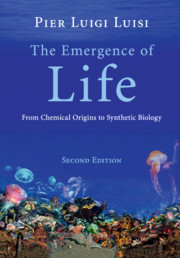Book contents
- Frontmatter
- Contents
- Acknowledgments
- Introduction
- Part I Approaches to the origin of life
- Part II What is life? The bio-logics of cellular life
- 6 Autopoiesis – the invariant property
- 7 Cognition
- Part III Order and organization in biological systems
- Part IV The world of vesicles
- Part V Towards the synthetic biology of minimal cells
- As a way of conclusion
- Appendix The open questions about the origin of life
- References
- Names index
- Subject index
6 - Autopoiesis – the invariant property
from Part II - What is life? The bio-logics of cellular life
Published online by Cambridge University Press: 05 September 2016
- Frontmatter
- Contents
- Acknowledgments
- Introduction
- Part I Approaches to the origin of life
- Part II What is life? The bio-logics of cellular life
- 6 Autopoiesis – the invariant property
- 7 Cognition
- Part III Order and organization in biological systems
- Part IV The world of vesicles
- Part V Towards the synthetic biology of minimal cells
- As a way of conclusion
- Appendix The open questions about the origin of life
- References
- Names index
- Subject index
Summary
Introduction
We have discussed in Part I various aspects of the origin of life, and some of the corresponding historical and philosophical aspects that generally attend this question. We will consider now the question, “What is life?” This is epistemically different from the question of the origin of life. In fact, this last query may start from the observation of already existing life, and its multiple forms on Earth – from microorganisms to algae, mushrooms, and plants to fish, birds, and mammals – and ask: “What do all these different things have in common, so that we can say for all of them, that they are living? What is the common denominator?” And, in keeping with the discussion in Chapter 1 of Part I, we want an answer at the level of the single individual. We cannot answer such a question with “self-reproduction.” Take all our mature neuron cells, or the cells of the heart muscle (cardiomiocytes), which do not self-reproduce. But they are alive, as they are engaged for all our life in metabolism – a form of homeostasis. And take all animals who do not reproduce because they are either too young or too old – are they not living? And to say that the dog running on the road is alive here and now, because he is the product of his parents’ conjunction two years earlier – is really not a sensible thing to say. Nor is it sensible to say that all organisms are alive because they derive from the reproduction activity of parent organisms. Self-reproduction is a property, one of its consequences. It is a characteristic of all living things, but it says nothing about the question “why is an organism alive?” We need a criterion of life that answers this question at the level of a single organism, here and now, regardless of its progenitors history. Such a criterion should illustrate the common denominator to all living things, despite their extreme diversity, and clarify the difference between living and not living; and the theory of autopoiesis does that.
Each living system, as an open system, has to interact with its own environment, and we will learn in the next chapter the important notion of cognition, which, still in the theory of autopoiesis, tells us the meaning of this interaction.
- Type
- Chapter
- Information
- The Emergence of LifeFrom Chemical Origins to Synthetic Biology, pp. 119 - 156Publisher: Cambridge University PressPrint publication year: 2016
- 1
- Cited by



